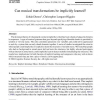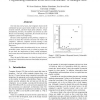269 search results - page 16 / 54 » Who Thinks Who Knows Who |
ECAI
2008
Springer
13 years 8 months ago
2008
Springer
This paper describes a novel method for explaining Bayesian network (BN) inference when the network is modeling a population of conditionally independent agents, each of which is m...
COGSCI
2004
13 years 6 months ago
2004
The dominant theory of what people can learn implicitly is that they learn chunks of adjacent elements in sequences. A type of musical grammar that goes beyond specifying allowabl...
CHI
2003
ACM
14 years 7 months ago
2003
ACM
An Exertion Interface is an interface that deliberately requires intense physical effort. Exertion Interfaces have applications in "Sports over a Distance", potentially ...
HICSS
2006
IEEE
14 years 23 days ago
2006
IEEE
Over the last several years, the Computer Science (CS) community has put a great deal of effort in to the area of security research, and have made great advances. Counterintuitive...
ACMSE
2006
ACM
14 years 21 days ago
2006
ACM
Like in other fields, computer products (applications, hardware, etc.), before being marketed, require some level of testing to verify whether they meet their design and function...


